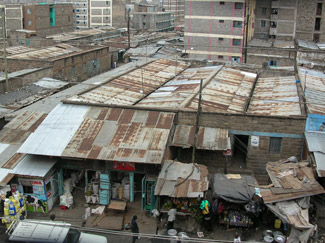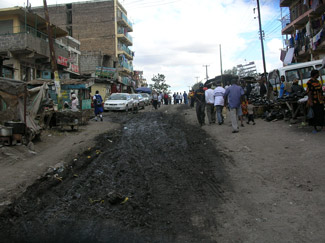Orphans of the Kibera & Mathare slum areas in Nairobi, Kenya
Although there are tens of thousands of orphaned children in Kenya,
two of the greatest concentrations are in the Kibera and Mathare slums of Nairobi. The Nadine Griffey Academy of Kenya will focus on these two areas in selecting our children for full educational/boarding school scholarships.
Kibera, the largest slum in Nairobi, has a population over 900,000. Roads and alleyways are littered with garbage and human waste. The filth and sewage run-off goes through open ditches and runs into the Nairobi River which is used by others downstream to wash clothes.
Mathare, with a population over 500,000, is the second largest slum. As with Kibera, families frequently live in small, one-room structures with no heat, electricity, toilets or running water. They have no beds so they must sleep on the floor. If you walk through the alleys, you see young children with old used plastic coke bottles full of water from some distant public source. Toys are non-existent, so children sit in the dirt and play with small pebbles and sticks. Most of the people live so far below the poverty level, just surviving is a day-to-day struggle.
Apart from extreme poverty in both Kibera and Mathare, there are thousands of children whose parents have died of HIV/AIDS. If these children are fortunate, they will have a living relative who will try to take care of them. It is not unusual to find an aunt or grandmother raising six or eight orphaned children.
Poor sanitation, disease, limited educational opportunities, and unsafe conditions are hallmarks of the cycle of poverty for thousands of children living in Nairobi’s slums.
While Kenya now offers a form of free education,
two problems remain: first, school uniforms are required and many cannot afford even these minimal costs. As a result, some children never attend school. Second, for those families who can pay for the basics, there is a serious lack of teachers; consequently, children may be bunched together in classes ranging from 100 to 150 students.
There are, of course, many wonderful churches that are doing their best to provide some form of education for those who cannot afford to attend the public schools. If you walk down through some of the small alleys, you will find these schools in small tin buildings with no windows or lights. There is often a sewage ditch running within two feet of the school. These are the fortunate children because these informal church schools will at least provide one good meal per day.
It is from these surroundings that the Nadine Griffey Academy of Kenya will select our children. Although we cannot solve the terrible problems inherent in the Kibera and Mathare slum areas, we can and will provide at least a few of the children with an opportunity for a better life.



